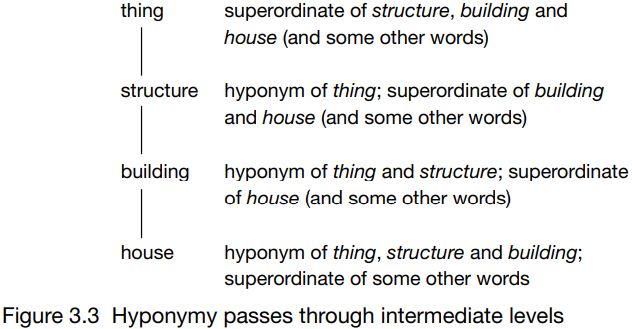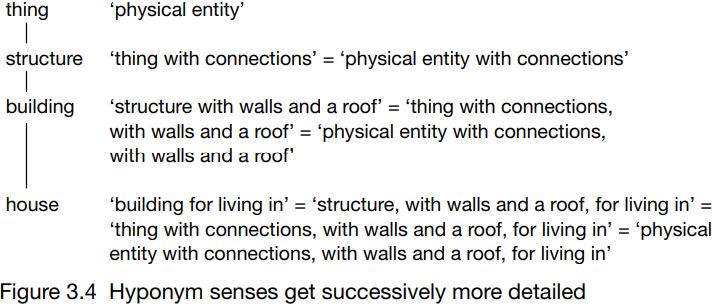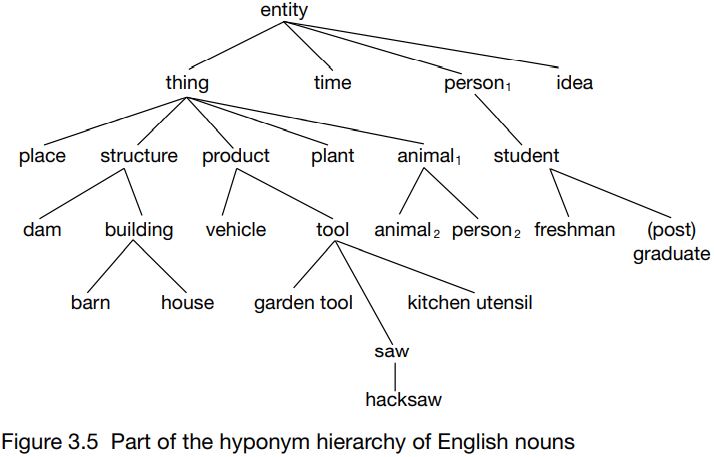


 Grammar
Grammar
 Tenses
Tenses
 Present
Present
 Past
Past
 Future
Future
 Parts Of Speech
Parts Of Speech
 Nouns
Nouns
 Verbs
Verbs
 Adverbs
Adverbs
 Adjectives
Adjectives
 Pronouns
Pronouns
 Pre Position
Pre Position
 Preposition by function
Preposition by function 
 Preposition by construction
Preposition by construction
 Conjunctions
Conjunctions
 Interjections
Interjections
 Grammar Rules
Grammar Rules
 Linguistics
Linguistics
 Semantics
Semantics
 Pragmatics
Pragmatics
 Reading Comprehension
Reading Comprehension|
Read More
Date: 2023-04-05
Date: 2024-07-13
Date: 12-2-2022
|
Hierarchies of hyponyms
House is a hyponym of the superordinate building, but building is, in turn, a hyponym of the superordinate structure; and, in its turn, structure is a hyponym of the superordinate thing. A superordinate at a given level can itself be a hyponym at a higher level, as shown in Figure 3.2

The hyponymy relation passes through intermediate levels in the hierarchy, which means that house is not only a hyponym of building, but is also a hyponym of building’s immediate superordinate, structure; and, via structure, house is also a hyponym of thing. Thing is a superordinate for all the words on lines that can be traced down from it in the hierarchy, and so on, as shown in Figure 3.3.

The significance of hyponymy passing through intermediate levels is that a hierarchy of this kind guarantees numerous inferences. Thus if someone who is speaking the truth tells us about a house, we know, with certainty and without having to ask, that the entity in question is a building, that it is a structure and that it is a thing.
The phrase and some other words is used in Figure 3.3 because the diagram shows only a fragment of the hierarchy. There are other kinds of thing besides structures (for example, plants are things); there are other kinds of structures besides buildings (for example, dams are structures); there are also words that are hyponyms of house (for example, cottage and bungalow). In Section 3.2.2, it will be seen that this interacts in an interesting way with the has-relation, making further inferences possible.
High in the hierarchy, the senses of words (the specifications that determine their denotation are rather general and undetailed, which has the consequence that these words denote many different kinds of entity. At successively lower levels, the meanings are more detailed and, therefore, the words denote narrower ranges of things (see Figure 3.4).

Please take ‘with connections’ as short for ‘with connections between its parts’. Notice that the meaning of a hyponym is the meaning of its immediate superordinate elaborated by a modifier; so the meaning of house is the meaning of building modified, in this case by the modifier ‘for living in’. Because building is itself a hyponym one level below structure, its meaning is that of structure plus a modifier, ‘with walls and a roof ’; and so on.
Figure 3.5 shows more of the hyponym hierarchy for nouns in English, though still only a small fraction of it. (Compound words like garden tool and postgraduate enter into semantic relations in the same way as simple words do.)
The ways in which Figure 3.5 is incomplete are obvious. There are different kinds of places (islands, summits, fields and villages, for instance). There are different kinds of times (for example, dawn, noon, evening). There are other products besides tools and vehicles (items of furniture, for instance). Buildings and dams are not the only kind of structures that exist (bridges are another). Students are not the only kind of person1; and so on. Person appears twice, in recognition of the ambiguity mentioned in Section 3.1.5: ‘physical person’, shown in Figure 3.5 as person2, a hyponym of animal1, and ‘psychological individual’, shown as person1, the immediate superordinate of student. Animal appears twice in the tree because it has two senses in ordinary English usage: animal1 ‘living thing other than plants’, which, of course, includes humans; and animal2 ‘animal1 other than humans’. It is person2 that bears the has-relation to the body parts .

Miller and Fellbaum (1991) report on the development of WordNet, a substantial and systematic computer database of English word meanings. By 1991 WordNet contained entries for more than 54,000 different words. In creating the database, they found that a hyponym hierarchy with twenty-six high-level superordinates, such as time, plant, animal and so forth, ‘provides a place for every English noun’ (1991: 204). The highest three levels in Figure 3.5 are largely based on their description of the hyponym hierarchy for nouns in English. To keep the diagram manageable, however, I have omitted nineteen of their twenty-six high-level superordinates; so Figure 3.5 represents merely a tiny sample of the full picture.
|
|
|
|
كيف تساهم الأطعمة فائقة المعالجة في تفاقم مرض يصيب الأمعاء؟
|
|
|
|
|
|
|
مشروع ضخم لإنتاج الهيدروجين الأخضر يواجه تأخيرًا جديدًا
|
|
|
|
|
|
|
أكثر من 5 آلاف وجبة يقدمها قسم المضيف يوميًّا لضيوف العراق من لبنان
|
|
|